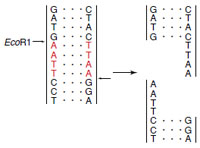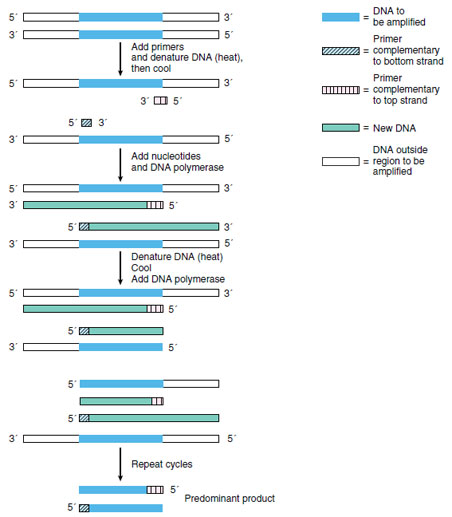Recombinant DNA
Recombinant DNA
One of the most important tools in this
technology is a series of enzymes
called restriction endonucleases.
Each of these enzymes, derived from
bacteria, cleaves double-stranded DNA
at particular sites determined by the
particular base sequences at that point.
Many of these endonucleases cut the
DNA strands so that one has several
bases projecting farther than the other
strand (Figure 5-23), leaving what are
called “sticky ends.” When these DNA
fragments are mixed with others that
have been cleaved by the same
endonuclease, they tend to anneal
(join) by the rules of complementary
base pairing. They are sealed into their
new position by the enzyme DNA
ligase.
Besides their chromosomes, most prokaryote and at least some eukaryote cells have small circles of double-stranded DNA called plasmids. Though comprising only 1% to 3% of the bacterial genome, they may carry important genetic information, for example, resistance to an antibiotic. Plastids in plant cells (for example, chloroplasts) and mitochondria, found in most eukaryotic cells, are self-replicating and have their own complement of DNA in the form of small circles reminiscent of plasmids. The DNA of mitochondria and plastids codes for some of their proteins, and some of their proteins are specified by nuclear genes. If the DNA annealed after cleavage by the endonuclease is from two different sources, for example, a plasmid (see note above) and a mammal, the product is recombinant DNA. To make use of the recombinant DNA, the modified plasmid must be cloned in bacteria. The bacteria are treated with dilute calcium chloride to make them more susceptible to taking up the recombinant DNA, but the plasmids do not enter most of the cells present. Bacterial cells that have taken up the recombinant DNA can be identified if the plasmid has a marker, for example, resistance to an antibiotic. Then, the only bacteria that can grow in the presence of the antibiotic are those that have absorbed the recombinant DNA. Some bacteriophages (bacterial viruses) have also been used as carriers for recombinant DNA. Plasmids and bacteriophages that carry recombinant DNA are called vectors. The vectors retain the ability to replicate in the bacterial cells; therefore the recombinant insert is amplified.
A clone is a collection of individuals or cells all derived by asexual reproduction from a single individual.When we speak of cloning a gene or plasmid in bacteria,we mean that we isolate a colony or group of bacteria derived from a single ancestor into which the gene or plasmid was inserted.
Polymerase Chain Reaction
Recent advances have made it a simple
task to clone a specific gene enzymatically
from any organism as long as part
of the sequence of that gene is known.
The technique is called the polymerase
chain reaction (PCR). Two
short chains of nucleotides called
primers are synthesized; primers are
complementary to different DNA
strands in the known sequence. A large
excess of each primer is added to a
sample of DNA from the organism, and
the mixture is heated to separate the
double helix into single strands. When
the mixture is cooled, there is a much
greater probability that each strand of
the gene of interest will anneal to a
primer than to the other strand of the
gene—because there is so much more
primer present. DNA polymerase is
added along with the four deoxyribonucleotide
triphosphates, and DNA
synthesis proceeds from the 3´ end of
each primer, extending the primer in
the 5´ to 3´ direction. If the primers are
chosen so that each anneals toward the
3´ end of each of the complementary
strands, entire new complementary
strands will be synthesized, and the
number of copies of the gene has doubled
(Figure 5-24). The reaction mixture
is then reheated and cooled again to
allow more primers to bind original and
new copies of each strand. With each
cycle of DNA synthesis, the number of
copies of the gene doubles. Since each
cycle can take less than five minutes,
the number of copies of a gene can
increase from one to over one million
in less than two hours! The PCR allows
cloning a known gene from an individual
patient, identification of a drop of
dried blood at a crime scene, or cloning
the DNA of a 40,000-year-old woolly
mammoth.
Recombinant DNA technology and the PCR are currently being used in many areas with great positive potential and many practical uses.
The techniques of molecular biology have allowed scientists to accomplish feats of which few could dream only a decade or so ago.These accomplishments will bring enormous benefits for humanity in the form of enhanced food production and treatment of disease. Progress with crop plants has been so rapid that genetically engineered soybean, cotton, rice, corn, sugarbeet, tomato, and alfalfa have already reached the market in the United States. There is resistance to sale of genetically altered produce in Europe, apparently because of widespread fears that such vegetables can somehow harm consumers.
Development of transgenic animals of potential use has not progressed as far as development of such plants.Gene therapy for inherited diseases presents many difficulties, but research in this area is vigorous,and clinical trials for certain conditions are under way.
 |
| Figure 5-23 Action of restriction endonuclease, EcoR1. Such enzymes recognize specific base sequences that are palindromic (a palindrome is a word spelled the same backward and forward). EcoR1 leaves “sticky ends,” which anneal to other DNA fragments cleaved by the same enzyme. The strands are joined by DNA ligase. |
Besides their chromosomes, most prokaryote and at least some eukaryote cells have small circles of double-stranded DNA called plasmids. Though comprising only 1% to 3% of the bacterial genome, they may carry important genetic information, for example, resistance to an antibiotic. Plastids in plant cells (for example, chloroplasts) and mitochondria, found in most eukaryotic cells, are self-replicating and have their own complement of DNA in the form of small circles reminiscent of plasmids. The DNA of mitochondria and plastids codes for some of their proteins, and some of their proteins are specified by nuclear genes. If the DNA annealed after cleavage by the endonuclease is from two different sources, for example, a plasmid (see note above) and a mammal, the product is recombinant DNA. To make use of the recombinant DNA, the modified plasmid must be cloned in bacteria. The bacteria are treated with dilute calcium chloride to make them more susceptible to taking up the recombinant DNA, but the plasmids do not enter most of the cells present. Bacterial cells that have taken up the recombinant DNA can be identified if the plasmid has a marker, for example, resistance to an antibiotic. Then, the only bacteria that can grow in the presence of the antibiotic are those that have absorbed the recombinant DNA. Some bacteriophages (bacterial viruses) have also been used as carriers for recombinant DNA. Plasmids and bacteriophages that carry recombinant DNA are called vectors. The vectors retain the ability to replicate in the bacterial cells; therefore the recombinant insert is amplified.
A clone is a collection of individuals or cells all derived by asexual reproduction from a single individual.When we speak of cloning a gene or plasmid in bacteria,we mean that we isolate a colony or group of bacteria derived from a single ancestor into which the gene or plasmid was inserted.
 |
| Figure 5-24 Steps in the polymerase chain reaction (PCR). |
Recombinant DNA technology and the PCR are currently being used in many areas with great positive potential and many practical uses.
The techniques of molecular biology have allowed scientists to accomplish feats of which few could dream only a decade or so ago.These accomplishments will bring enormous benefits for humanity in the form of enhanced food production and treatment of disease. Progress with crop plants has been so rapid that genetically engineered soybean, cotton, rice, corn, sugarbeet, tomato, and alfalfa have already reached the market in the United States. There is resistance to sale of genetically altered produce in Europe, apparently because of widespread fears that such vegetables can somehow harm consumers.
Development of transgenic animals of potential use has not progressed as far as development of such plants.Gene therapy for inherited diseases presents many difficulties, but research in this area is vigorous,and clinical trials for certain conditions are under way.




